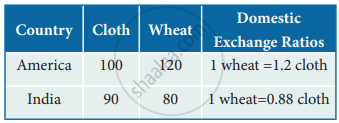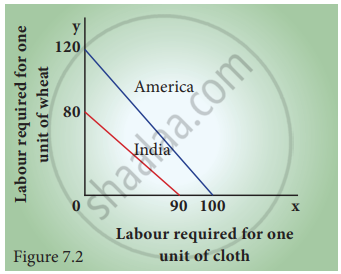Advertisements
Advertisements
Question
Explain briefly the Comparative Cost Theory.
Solution
Ricardo’s Theory of Comparative Cost Advantage:
- David Ricardo, the British economist in his ‘Principles of Political Economy and Taxation’ published in 1817, formulated a systematic theory called ‘Comparative Cost Theory’.
- Ricardo demonstrates that the basis of trade is the comparative cost difference. In other words, trade can take place even if the absolute cost difference is absent but there is a comparative cost difference.
- According to Ricardo, a country can gain from trade when it produces at relatively lower costs. Even when a country enjoys the absolute advantage in both goods, the country would specialize in the production and export of those goods which are relatively more advantageous.
Assumptions:
- There are only two nations and two commodities (2 × 2 models)
- Labour is the only element of the cost of production.
- All labourers are of equal efficiency.
- Labour is perfectly mobile within the country but perfectly immobile between countries, (v) Production is subject
- To the law of constant returns.
- Foreign trade is free from all barriers.
- No change in technology.
- No transport cost.
- Perfect competition.
- Full employment.
- No government intervention.
Illustration:
Ricardo’s theory of comparative cost can be explained with a hypothetical example of production costs of cloth and wheat in America and India.

It is evident from the example that India has an absolute advantage in the production of both cloth and wheat.

However, India should concentrate on the production of wheat in which it enjoys a comparative cost advantage. (80/120 < 90/100). For America, the comparative cost disadvantage is lesser in cloth production. Hence America will specialize in the production of cloth and export it to India in exchange for wheat. (Any exchange ratio between 0.88 units and 1.2 units of cloth against one unit of wheat represents again for both the nations).
With trade, India can get 1 unit of cloth and 1 unit of wheat by using its 160 labour units. In the absence of trade, for getting this benefit, India will have to use 170 units of labour. America also gains from this trade. With trade, America can get 1 unit of cloth and one unit of wheat by using its 200 units of labour. Otherwise, America will have to use 220 units of labour for getting 1 unit of cloth and 1 unit of wheat.
APPEARS IN
RELATED QUESTIONS
In general, a primary reason why nations conduct international trade is that ______.
Which of the following is a modern theory of international trade?
Net export equals ______.
What is the main difference between Adam Smith and Ricardo with regard to the emergence of foreign trade?
Compare the Classical Theory of international trade with the Modern Theory of International trade.
Discuss the Modern Theory of International Trade.
